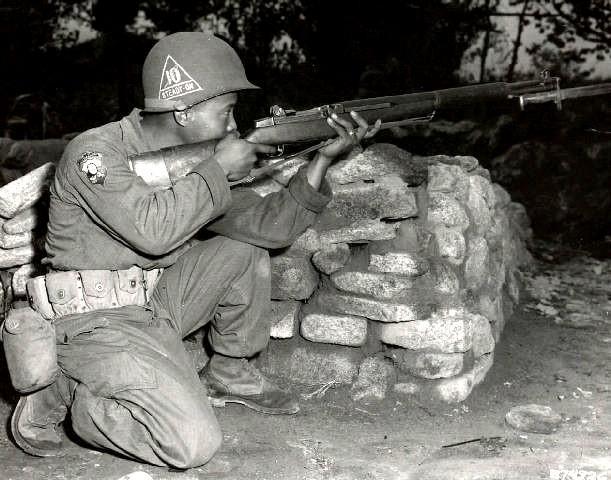-
Contributing Member


15-179 Garand Picture of the Day


U.S. RIFLE M1 .30 SN# 5148188
.30 SN# 5148188
Manufactured by International Harvester, Evansville, In. in 1954 - Standard M1 gas-operated semi-automatic rifle made on contract by International Harvester. Fed by 8-shot, staggered column, "en bloc" clip. Muzzle velocity 2800 fps. Weapon weighs approximately 9.5 lbs.
Markings:
Receiver: U.S. RIFLE/CAL. .30 M1/INTERNATIONAL/HARVESTER/5148188.
Barrel: LMR. 3-54.
Stock: P in circle. Defense Acceptance Stamp.
Weapon transferred to the Museum on 15 December 1966. At that time weapon was appraised at $94.30.
Notes: "International Harvester Corporation was awarded Contract Number DA-33-008-ORD-149 on 15 June 1951 for production of complete M1 rifles to be produced in their Evansville, Indiana plant...International made its initial deliveries in December of 1952.
These rifles were to be produced in a small area of IHC's Evansville, Indiana plant. The reason IHC was chosen was the result of the government's 'geographic dispersion plan.' The bulk of the military arms producing industry was centered in the New England area. The advent of the atomic bomb and rockets capable of delivering them made this a most uncomfortable situation.
area. The advent of the atomic bomb and rockets capable of delivering them made this a most uncomfortable situation.
The plant in which IHC M1's were produced was the former Republic Aviation Plant, P-47 Thunderbolts were formerly produced there during World War II. IHC had converted this facility for the manufacture of refrigerators, freezers, and window air conditioning units.
Adjacent to this plant, near a railroad siding, was another building called the firing house; all proof, function, and targeting operations were performed in this building.
Obviously, International Harvester Corporation had a great deal of manufacturing experience, but none with small arms production. Springfield Armory assisted IHC in furnishing a complete set of reproducible drawings for tools, fixtures, gages and components. Also, the Armory provided sample components, and literally hundreds of partially completed components used for checking machine tools on the pilot line." - Scott A. Duff
"...Commercial production of military rifles in the post-war period was a disaster. On June 13, 1951 and April 13, 1952, International Harvester and Harrington & Richardson respectively received contracts for the production of the M1 Rifle. Both companies had their difficulties. The International Harvester program was a complete fiasco. In the final months of 1953, the Ordnance Corps ordered the Springfield Armory to set up for manufacture of four M1 Rifle components to bail out that firm. In particular, the Armory had to fabricate 10,000 M1 Receivers (the backbone of the weapon) to enable International Harvester to proceed with assembly of the rifle. According to Armory personnel these receivers were charged to the Armory's overhead, thus increasing the operating costs of Springfield and enhancing the profits of International Harvester....
The quality of M1 Rifles produced by private industry, though acceptable, was considerably lower than that of M1's produced by Springfield Data drawn from inspection records for the period May 1, 1954 to May 1, 1955 reflects the difference in Armory and commercially produced rifles. In the 'Function Firing Test' the Springfield M1 Rifles had 68 malfunctions per 1000 rifles tested. Those made by International Harvester had 140 per 1000 and those fabricated by Harrington & Richardson yielded 99 malfunctions per 1000. In four other quality control categories the quality control categories the quality of the commercial rifles was far below that of the Springfield weapons." - THE DEATH OF THE ARSENAL SYSTEM: THE DECISION TO CLOSE THE SPRINGFIELD ARMORY, Edward C. Ezell.
"The International Harvester M1's were numbered in 4,400,000 to 5,200,000 serial number range. Most barrels of authentic International Harvester Garands were marked 'IMR' and dated 1953-1956. Again, major component parts will be marked with the initials of the maker (IHC).
The rifles produced by Harrington & Richardson and International Harvester were not all numbered consecutively. Rather, theThe practice of stamping the stocks of U.S. martial arms with a cartouche containing the initials of the inspector ceased in the early 1950s. Arms which passed inspection after this period were stamped on the stocks with the Department of Defense acceptance mark consisting of three stars over a spread eagle.
M1 Korean Era Service Rifle International Harvester Corporation
Serial number from approximately 4,400,000 to 5,200,000.
Receiver marked 'International Harvester".
Barrels marked usually 'LMR' and dated 1953-1956.
Information
 |
Warning: This is a relatively older thread
This discussion is older than 360 days. Some information contained in it may no longer be current. |
|
Last edited by Bob Womack; 06-29-2015 at 01:49 PM.
He is no fool who gives what he cannot keep to gain that which he cannot lose
There are no great men, only great challenges that ordinary men are forced by circumstances to meet.
-
The Following 5 Members Say Thank You to Mark in Rochester For This Useful Post:
-
06-29-2015 12:16 PM
# ADS
Friends and Sponsors

.30 SN# 5148188
area. The advent of the atomic bomb and rockets capable of delivering them made this a most uncomfortable situation.


















 PM
PM






